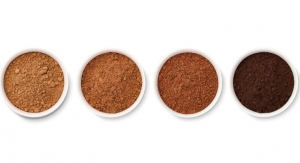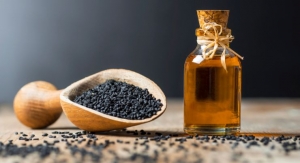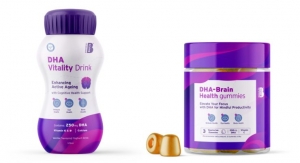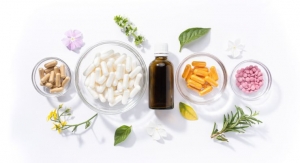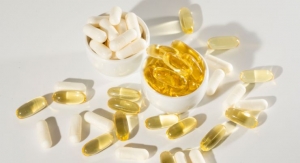Alan Richman, Contributing Writer11.01.13
There’s more than water in the sea. Increasingly, scientists, nutritionists and consumers are finding that the oceans—long thought to be the spawning ground of life itself—also hold innumerable treasures that support health and well-being.
Not least of these worthies are omega 3 fatty acids. Even the ancients recognized fish as “brain food.” Now there is extensive scientific evidence to uphold not only that premise but also their contributions to heart health, immune function, joint flexibility, eye health and, perhaps, added longevity.
Meanwhile, omega 3s alone don’t come close to covering the burgeoning marine nutraceuticals sector. One must also look at astaxanthin, crypthecodinium, spirulina, chlorella, Dunaliella salina, glucosamine and chondroitin, collagen and green-lipped mussels, as well as a variety of minerals and bioactive compounds. There are more choices here than at a Las Vegas buffet.
Show Me the Money
Not to impugn suppliers’ altruistic impulses, but few would be bothering with this category if it didn’t represent strong business potential. Ellen Schutt, communications director for the Salt Lake City, UT-based Global Organization for EPA and DHA Omega-3s (GOED), said her organization commissioned a Frost & Sullivan report showing that the global market for omega 3 raw materials was $1.8 billion in 2011. This equated to 103,284 metric tons. The U.S. number was $729 million.
Executives at Epax AS, Oslo, Norway, have an expansionary view of where the sea sector is going. Gunilla Traberg, head of marketing, reported double-digit increases over the past couple of years and estimated that growth will continue at approximately 12% annually until 2016.
“The main driver has been the massive clinical work being done,” she said. “Omega 3s are currently one of the most researched compounds in healthcare. There are more than 23,000 published papers and 2,500 human clinical trials. This scientific research has led to increased awareness of omegas, as even more data show the importance of this ingredient for all life stages.”
Also important, said Ms. Traberg, are omega 3 production technology improvements that have led to better yield and made higher concentrates available at more affordable prices.
Meanwhile, sources from the Scoular Company, Minneapolis, MN, suggested that sustainability is becoming an ever more important consideration. Emilie Slaby, a senior product development specialist, said, “Over the last five years, world capture of fish has been roughly stagnant while aquaculture production has grown at 6.5% annually. Consumers understand that they need to not only live well, but live well sustainably.”
In addition to omega 3 ingredients that have been developed from algae over the last decade, Ms. Slaby looks for “an increasing focus on bioactives derived from marine microorganisms. These microorganisms will be increasingly cultivated indoors via fermentation, a safe, controlled environment.”
Also on the radar are “more genetically modified organisms serving as bioactive factories to produce nutraceutical and cosmeceutical ingredients,” she said.
Think Pink…
Astaxanthin, which gives salmon and flamingos their pink color, could be a huge market on its own, according to statements by OriginOil, Los Angeles, CA, and Garden State bioEnterprises (GSbioE), Woodbine, NJ. Bolstered by findings from Oilgae, a research firm in Tamil Nadu, India, they forecasted worldwide astaxanthin sales of nearly $2 billion by 2020, with uses in antioxidant nutraceuticals, pharmaceuticals, cosmetics and food coloring.
There is a catch, however. Although astaxanthin is priced at about $4,000 a kilo, it is a difficult substance with which to work. It has to be produced by using ultraviolet (UV) light to stress Haematococcus pluvialis (HP) green algae into producing a red-tinted shell that contains the high-value component. The challenge is to grow the algae despite “crashes” caused by bacteria and other factors, and then to concentrate it without losing its ability to produce the astaxanthin-bearing shell.
OriginOil claims to have figured out a way around the challenge. The company’s CEO, Riggs Eckelberry, said it has developed a harvesting technology that can “reduce the bacteria levels in the water, so HP won’t crash so easily.” As a result, cultivators can “safely harvest the HP in a concentration that makes it much easier to stress the algae.”
Andrew Greene, president of GSbioE, reported, “By deploying the OriginOil Algae Appliance, we were able to harvest the algae to a 5% solids concentration while keeping the algae cells viable.”
Valensa International, Eustis, FL, is another company making news with astaxanthin. In a press release issued on Sep. 26, the company, a science-based developer and provider of nature-sourced products for nutritional supplements and functional foods, announced a multi-year agreement with La Jolla, CA-based Contract Biotics, a wholesale producer of a wide variety of algae biomass and related biological compounds.
The pact calls for Contract Biotics to supply Valensa with commercial quantities of algae biomass needed for the successful production of high-quality astaxanthin. Rudi Moerck, PhD, Valensa’s president and CEO, noted that difficulty in obtaining sufficient biomass has been a “limiting factor on the growth of the astaxanthin market for the last several years, even as demand has ramped up.”
Contract Biotics CEO Ken Reynolds said, “Many startups significantly underestimate the requirements and cost of QA/QC and Good Manufacturing Practices. Valensa’s expertise and capabilities in this area have been invaluable as they allow us to focus on what we do best, which is to grow tons of algae”
…Or Red…Or….
Crypthecodinium cohnii is a species of dinoflagellate microalgae, according to a 2007 publication from Martek Biosciences, which was acquired by Parsippany, NJ-based DSM Nutritional Products in 2011. It is used industrially in the production of the essential fatty acid docosahexaenoic acid (DHA).
As described by La Molina of Hayward, CA, exclusive U.S. distributor for nutritional ingredients manufactured by Taiwan-based FEBICO, Crypthecodinium cohnii, also known as red algae, is a major source of DHA, often associated with helping to reduce or inhibit risk factors involved in cardiovascular diseases, as well as inflammatory and immune disorders. DHA is also widely recognized as important for brain development in infants and children.
WebMD, an Internet-based source of health information, identifies chlorella as a type of algae that grows in fresh water. A good source of protein, fats, carbohydrates, fiber, chlorophyll, vitamins and minerals, it has been credited with various beneficial effects. These include: improved digestion; alleviation of ulcers, colitis, Crohn’s disease and diverticulosis; easing of constipation, bad breath and hypertension; antioxidant activity; lowering of cholesterol; increased energy; and more.
Widely read author Joseph Mercola, DO, described the blue-green algae spirulina as “a plant that can nourish your body by providing most of the protein you need to live, help prevent the annoying sniffling and sneezing of allergies, reinforce your immune system, help you control high blood pressure and cholesterol, and help protect you from cancer.”
A blog published by supplement manufacturer Arcadian Nutraceuticals, which is headquartered in Australia, said, “Dunaliella salina is a soft wall, single cell, edible species of marine microalgae found in the remote coastal waters off northwestern Australia.”
As a source of the carotenoids alpha- and beta-carotene, lutein, zeaxanthin and cryptoxanthin, the ingredient may be useful to protect against “free radical cell damage responsible for premature aging, cataracts, cardiovascular disease and other chronic diseases,” said the company.
The same blog also suggested that green-lipped mussels, eaten for centuries by the indigenous Maori people of New Zealand, contain “important compounds called mucopolysaccharides, which play a major role in the structural integrity of all body tissues and, most importantly, are necessary for joint lubrication.”
Arcadian Nutraceuticals cited clinical research showing that “regular consumption of green-lipped mussels or their extract may help to reduce joint pain, improve flexibility and rebuild lost cartilage, as well as help to maintain good health and well-being.”
As for glucosamine and chondroitin, these two ingredients are already implanted firmly in the supplementation regimens of millions of people worldwide. And, it would seem, with good reason.
The National Institutes of Health (NIH)-sponsored Glucosamine/Chondroitin Arthritis Intervention Trial (GAIT) study, completed in June 2010, concluded that among subjects with moderate–to-severe pain caused by osteoarthritis, glucosamine and chondroitin taken together relieved discomfort 25% more effectively than prescription drugs like Celebrex or even each of the two supplements taken individually. Glucosamine is commonly sourced from the exoskeletons of shellfish, and its partner chondroitin generally comes from bovine cartilage, but also is found in sharks and other fish.
Pure Marine Collagen Peptide, a trademarked, hydrolyzed, pure protein made up of amino acids, is offered by Certified Nutraceuticals of Murrieta, CA. Ahmad Alkayali, the company’s CEO and president, said, “There’s no cholesterol, sugar or fat in our protein so it can be added to meals to provide a pure protein boost. When collagen is hydrolyzed, the protein molecules are broken into smaller molecules. A hydrolyzed protein will be easier to digest and will be absorbed by the body faster and easier than a non-hydrolyzed protein.”
Because his company’s collagen is produced from the skins of wild, deep-sea, ocean fish such as cod, haddock and pollock, Mr. Alkayali said there is “no possibility of exposure to antibiotics or hormones as is possible with farm-raised animals or fish. In addition, since only the skins of kosher fish are used, our product is able to meet the strict kosher standards of the Orthodox Union.”
Keeping It Fresh
While most marine nutraceuticals come from saltwater, there are also significant contributions from freshwater sources. For example, New Earth, Klamath Falls, OR, has been operating for 30 years as a harvester of microalgae and fungi based products that are kosher, halal, USDA-certified organic and NSF GMP registered.
Among the company’s products, said Bruce Artman, vice president of research and development, are Wild Water, a proprietary blend of nine colorful algae that are rich in minerals from both the lake and the sea, and organic Wild Bluegreen Body, which is promoted as having benefits for immune system function, physical performance and support of the ability to resist stress.
In addition, Mr. Artman said, research on fucoidans, which are found in brown marine macroalgae, suggests that these substances have “good immune-modulating activity and may positively affect inflammatory and immune response.”
He emphasized, “Benefits derived from animal members of the marine environment are well known and have been studied for some time. Benefits derived from plant members of the marine environment are a newer area of exploration, and we are seeing some exciting and promising research relating to human health.”
This area of research is likely to get a boost from an agreement announced Sep. 17 by Health Enhancement Products, Inc. (HEPI), of Bloomfield Hills, MI, and the Arizona Center for Algae Technology and Innovation (AzCATI), located at the Arizona State University Polytechnic campus in Mesa, AZ, and the Algae Test-bed Public-Private Partnership (ATP3).
HEPI President and CEO Andrew Dahl said the scope of the research project includes: development of a technique to rapidly screen organisms for bioactivity; development of methods for quantification of bioactive compounds; investigating the mode of synthesis for bioactive compounds; mass-culturing organisms that produce bioactive compounds for bovine and canine trials.
“In HEPI’s years of research we have identified bioactive molecules with verifiable health benefits for humans and animals that have attracted quite a lot of attention from potential licensors,” said Mr. Dahl. “Now is the appropriate time to commercialize the research, beginning with the cultures and organisms responsible for creating the bioactive compounds.”
According to Mr. Dahl, the collaboration with AzCATI/ATP3’s Dr. Thomas Dempster and Dr. Henri Gerken has yielded a positive outcome from the very start. “We were able to immediately kick off a complex and aggressive development program that will get our product validated and market-ready within a reasonable timeframe.”
Omega 3: The Living End
In the Greek alphabet, omega is the last letter, signaling the end. Not so in nutrition. In fact, omega fatty acid ingredients are so hot, they’re cool (or the other way around, depending on how you like your slang). The point is they are selling, and they are selling because they perform; proof of performance exists in a large body of research. Here are some examples…
In one study sponsored by Issaquah, WA-based Aker BioMarine, participants started out with an average Omega-3 Index of 2.0, a relatively low value. After eight weeks of daily supplementation with two grams of Aker’s Superba Krill, the average index went up to 4.5, an increase of 125%. In fact, an increase of 45% in the Omega-3 Index was seen after just two weeks.
“These observations show that the omega 3s from Superba Krill are taken up from the gut to the bloodstream and that EPA and DHA are incorporated into cells,” said Becky Wright, the company’s communications and marketing manager.
Aker also recently published a pilot study on krill powder in Lipids in Health and Disease. Currently under development, the new powder product provides phospholipid omega 3 fatty acids suitable for tablet applications.
In this study, 11 obese men underwent 24 weeks of treatment with Superba Krill powder. Then researchers assessed blood lipids and endocannabinoids (a class of lipid signaling molecules that are poorly regulated in obese subjects), as well as a variety of other parameters. Superba Krill powder reduced triglyceride levels by 21%. It also positively impacted three different endocannabinoids, including anandamide, which decreased 84% by the end of treatment. Researchers also noted a significant improvement in the waist/hip ratio and visceral fat/skeletal muscle mass of the study participants.
Wael Massrieh, PhD, vice president of scientific affairs at Neptune Technologies & Bioressources Inc., Laval, Quebec, Canada, said his company produces two krill oil lines—NKO, a branded version (often cobranded on distributors’ products) that blends EPA, DHA in the form of phospholipids and astaxanthin, and EKO, a generic product that also combines EPA, DHA and astaxanthin.
According to Dr. Massrieh, “It is now known that omega 3s have the ability to control transcription factor activity, which in turn regulates gene expression and metabolic pathways such as glycolysis, lipid biosynthesis, fatty acid elongation, desaturation and oxidation.”
He claimed that the difference between krill oil and omega 3s taken from fish is that krill “involves two other naturally occurring bioactives, namely phospholipids and astaxanthin. These two components confer on krill oil a wider scope of benefits.”
Dr. Massrieh cited a study showing that supplements derived from krill oil down-regulated the activity of pathways involved in hepatic glucose production as well as lipid and cholesterol synthesis. These same data, he said, also suggested that krill oil supplementation increases the activity of the mitochondrial respiratory chain. In the future, he remarked, “We can expect research will focus more on how krill oil is different from, rather than similar to, fish oil.”
At DSM, where leading products include MEG-3, from fish oil, and life’sDHA, a vegetarian version of DHA taken from algae, two recent studies attest to benefits conferred by omega 3s. Laura King, marketing manager, said that one of these, conducted by the University of Kansas Medical Center and published in April of this year, found that supplements of the omega 3 fatty acid DHA might lengthen gestation and increase birth size. The research team was led by Susan Carlson and appeared in the American Journal of Clinical Nutrition.
In the other study, published in September 2012 and known as the DHA Oxford Learning and Behavior (DOLAB) trial, increased dietary intake of algal DHA in school-aged children with low reading levels supported significant improvements in reading performance and behavior.
The newest ingredient from the Scoular Company is Romega, a DHA omega 3 oil purified from Norwegian herring caviar. The company’s Ms. Slaby described Romega as “a combination of omega 3 triglycerides and the highly sought after omega 3 phospholipids, widely considered to be the most bioavailable form.” According to Ms. Slaby, 30% and 50% grades are available.
The Scoular executive said that a “great deal of new research” is fueling growth in the popularity of the omega 3 category, and some of this is gender-driven. “Women may be more drawn to DHA-rich sources of omega 3 because of research connecting DHA to healthy pregnancy outcomes. Men may be more drawn to EPA-rich sources because of the scientific research substantiating its impact on cardiovascular health,” she said.
Discovering and encouraging new omega 3 delivery technologies is high on the list at Wilton, CT-based Arista Industries, said Mary Ann Siciliano, national sales manager. She described the company’s products as omega 3 fish oils from sardine and anchovy, salmon, cod and krill, as well as fish oil powders, which are used in functional foods, supplements and pharmaceutical preparations.
According to Ms. Siciliano, thanks to high concentration oil loads, the powders can be used in functional foods in smaller quantities with a less discernible odor than straight fish oil.
At Epax, the company specializes in manufacturing and supplying premium grade, marine-derived EPA/DHA omega 3 fatty acids, said Ms. Traberg. These include “condition-specific formulas with various concentrations and EPA/DHA ratios targeting different health problems.”
“One of the most exciting new emerging sciences in the field of marine-based omega 3 fatty acids is its role in the aging process,” said Ms. Traberg. “This work is based on research conducted by Dr. Elizabeth Blackburn on telomeres. She shared the Nobel Peace Prize for medicine in 2009 for her discovery. Telomeres are stretches of DNA that cap the ends of chromosomes and help keep the cells in the human body from aging too soon. The telomeres become shorter as a result of wear and tear. When they become too short, the cell can no longer function normally. A significant reduction in telomere length is related with aging and several diseases such as cancer.”
The Epax executive cited a recently published study that evaluated a standard U.S. diet with the addition of marine omega 3 fatty acids. “The results were striking,” she reported. “Telomere length increased in the omega 3 group while the group given the typical U.S. diet showed reduction in telomere length.”
The Omega Debate
Epax’s Ms. Traberg acknowledged a continuing debate about which form of omega 3—ethyl esters, triglycerides or free fatty acids—are the best to produce and sell. As there are considerable price differences among these varieties, consumers often find it difficult to decide which type to buy, she opined.
Like the folks at Arista Industries, and probably many other suppliers as well, Epax management is alert to the explosion of new delivery forms in the omega 3 market, said Ms. Traberg. No longer confined to the traditional pathways of pure oil or soft gel, the firm has been working with emulsions, nano-microencapsulated powder and liposomes. “Most likely, these will be more applicable for the functional food market than the supplement market but will, we hope, increase the total intake of marine-based omega 3 fatty acids,” she said.
Patrick Luchsinger, marketing manager, Nutrition, at Ingredion Incorporated, Westchester, IL, said his company offers two marine nutraceutical ingredients. He described Aquamin as a “multi-mineral marine calcium source, derived from calcified red algae, Lithothamnion calcareum, which grows in the cold European waters off the coasts of Ireland and Iceland.” Boasting implications for bone health, it contains not just calcium but approximately 70 other trace minerals, with magnesium being the second highest in percentage after calcium.
The other marine nutraceutical from Ingredion is Marine Derived Magnesium, which, Mr. Luchsinger said, is sourced from calcined (heated) seawater. “It is a natural form of magnesium hydroxide and contains a minimum of 35% magnesium. Magnesium is being recognized more and more for its support in cardiovascular and bone health,” he added.
According to Mr. Luchsinger, Aquamin has been extensively studied since 2009. He cited one randomized, double-blind, placebo-controlled parallel group study (Frestedt 2008 et al, published in Nutrition Journal), which evaluated the impact of treatment with Aquamin on walking distance, pain and joint mobility in subjects with moderate-to-severe osteoarthritis of the knee. Aquamin showed significant improvements for all parameters on the Western Ontario and McMasters Universities Osteoarthritis Index (WOMAC), he reported.
Novel Ingredient Services, West Caldwell, NJ, was announced on Aug. 19 as the exclusive U.S. distributor of GC Rieber Oils, a supplier of Norwegian fish oils with concentration levels ranging from 60% to 90% total omega 3s.
According to Bob Green, Novel’s president, the signature product VivoMega 70 DHA Ultra contains 90% omega 3s, a high concentration ensuring its bioavailability and potency.
Mr. Green noted that one of the more appealing attributes of GC Rieber Oils is that it is “extremely nimble—perhaps because it is independently owned—so the people there are able to customize ingredients much more quickly than the other industry suppliers. This is an ideal fit for Novel since providing custom ingredient manufacturing solutions is as central to our business as providing high performance, value-priced raw materials.”
Strength Through Association
The Marine Stewardship Council, with a U.S. office in Seattle, WA, doesn’t research products for efficacy, but, as an association dedicated to setting standards for sustainable fishing, it does conduct a DNA testing program as part of its strategy to monitor the integrity of its Chain of Custody standard for seafood traceability.
Kerry Coughlin, regional director for the Americas, said the group operates the world’s leading ecolabel and certification program for wild-caught seafood. “When buyers and consumers see the blue MSC ecolabel they can be sure that product is traceable back to a fishery that has been certified to the MSC’s rigorous environmental standard as a sustainable and well-managed fishery,” she stated.
Moreover, said Ms. Coughlin, “The standard ensures the fish stocks are healthy, the impact of fishing on the marine ecosystem is minimal, and the fishery is well-managed. Fisheries around the world voluntarily come forward to be assessed against the MSC standard and the open, transparent evaluation process is conducted by an independent, third-party certifier with full stakeholder engagement.
“Once a fishery is certified,” she continued, “all companies in the supply chain must have MSC Chain of Custody certification, which ensures MSC labeled seafood can be traced back to a certified source.”
GOED is another association performing valuable services for omega 3 suppliers and the customers they serve. Harry Rice, vice president of regulatory and scientific affairs, continually monitors important product developments as well as medical and nutritional research related to EPA and DHA. Asked to identify lessons from the latest science in this field, Mr. Rice cited three cardiovascular health studies, two cognitive health studies, one on breast cancer, one on prostate cancer and one on eye health.
In one of the cardiovascular health studies (Mozaffarian et al), conducted this year, omega 3 levels were associated with lower total mortality—27% lower risk when comparing lowest intakes to highest intakes. This translated into living an extra two-plus years. The findings support an average target dietary range of 250-400 mg of EPA plus DHA per day, Mr. Rice said.
“Substantiation for the cognitive benefits of the long-chain omega 3s are second only to the cardiovascular benefits,” said Mr. Rice. In Colombo et al (Am J Clin Nutr, Aug 2013), he said, supplementation with long-chain polyunsaturated fatty acids (LCPUFA) were found to have “significant positive effects” in children aged 3 to 5, with regard to rule-learning and inhibition tasks (the Peabody Picture Vocabulary Test at 5 years, and the Wechsler Primary Preschool Scales of Intelligence at 6 years).
In Montgomery et al, also cited by Mr. Rice and published this year by the Public Library of Science (PLOS ONE), the researchers conducted a cross-sectional analysis from the DOLAB study, and confirmed that below average reading ability in children aged 7 to 9 equated with low concentrations of LCPUFA. The scientists concluded, “These findings … suggest that the benefits from dietary supplementation with omega-3 LCPUFA found for ADHD, dyspraxia, dyslexia, and related conditions might extend to the general school population.”
In Zheng JS et al, published this year by the British Medical Journal (BMJ), Mr. Rice reported, “The authors concluded that high intakes of marine n-3 PUFAs (EPA + DHA + DPA) are associated with a 14% reduction in risk of breast cancer and that each incremental intake of 0.1 g/day was associated with a 5% reduction in risk of breast cancer.” Nevertheless, he noted, the majority of the included studies failed to adjust for important breast cancer risk factors like hormone replacement therapy and body mass index (BMI). Thus, the results fall short of influencing public policy, but they do provide what Mr. Rice called “a compelling reason” to conduct well-controlled long-term intervention studies.
Not all the research cited by Mr. Rice produced such positive results. Some studies showed, at best, neutral results for DHA and EPA supplementation. About these, Mr. Rice said, “Very rarely do we see the publication of well-designed studies that yielded less than favorable results; however, the publication of poorly designed studies where the media went too far with its extrapolation of the data and failed to provide adequate perspective and context around the findings happens all too often.”
Here Comes Big Pharma
Meanwhile, GOED’s Ms. Schutt called attention to a major trend in the omega 3 market—the “looming entry of several pharmaceutical products onto the market. There are more than 30 pharma products in the pipeline at various stages of development and the approval of even a few of these will dramatically change the supply situation within the market.”
On the positive side, Ms. Schutt praised potential consideration by the U.S. and Canadian governments for a DRI (dietary reference intake) for omega 3s. “This is exciting news,” she said. “The U.S. and Canada are among the few developed countries worldwide that do not have a recommended intake for EPA and DHA, and the regulatory support of the governments would help tremendously in acceptance and compliance for more consumers.”
New Jersey-based freelance writer Alan Richman is the former editor/associate publisher of Whole Foods Magazine and a regular contributor to Nutraceuticals World. He can be contacted at alanrichman@yahoo.com.
Not least of these worthies are omega 3 fatty acids. Even the ancients recognized fish as “brain food.” Now there is extensive scientific evidence to uphold not only that premise but also their contributions to heart health, immune function, joint flexibility, eye health and, perhaps, added longevity.
Meanwhile, omega 3s alone don’t come close to covering the burgeoning marine nutraceuticals sector. One must also look at astaxanthin, crypthecodinium, spirulina, chlorella, Dunaliella salina, glucosamine and chondroitin, collagen and green-lipped mussels, as well as a variety of minerals and bioactive compounds. There are more choices here than at a Las Vegas buffet.
Show Me the Money
Not to impugn suppliers’ altruistic impulses, but few would be bothering with this category if it didn’t represent strong business potential. Ellen Schutt, communications director for the Salt Lake City, UT-based Global Organization for EPA and DHA Omega-3s (GOED), said her organization commissioned a Frost & Sullivan report showing that the global market for omega 3 raw materials was $1.8 billion in 2011. This equated to 103,284 metric tons. The U.S. number was $729 million.
Executives at Epax AS, Oslo, Norway, have an expansionary view of where the sea sector is going. Gunilla Traberg, head of marketing, reported double-digit increases over the past couple of years and estimated that growth will continue at approximately 12% annually until 2016.
“The main driver has been the massive clinical work being done,” she said. “Omega 3s are currently one of the most researched compounds in healthcare. There are more than 23,000 published papers and 2,500 human clinical trials. This scientific research has led to increased awareness of omegas, as even more data show the importance of this ingredient for all life stages.”
Also important, said Ms. Traberg, are omega 3 production technology improvements that have led to better yield and made higher concentrates available at more affordable prices.
Meanwhile, sources from the Scoular Company, Minneapolis, MN, suggested that sustainability is becoming an ever more important consideration. Emilie Slaby, a senior product development specialist, said, “Over the last five years, world capture of fish has been roughly stagnant while aquaculture production has grown at 6.5% annually. Consumers understand that they need to not only live well, but live well sustainably.”
In addition to omega 3 ingredients that have been developed from algae over the last decade, Ms. Slaby looks for “an increasing focus on bioactives derived from marine microorganisms. These microorganisms will be increasingly cultivated indoors via fermentation, a safe, controlled environment.”
Also on the radar are “more genetically modified organisms serving as bioactive factories to produce nutraceutical and cosmeceutical ingredients,” she said.
Think Pink…
Astaxanthin, which gives salmon and flamingos their pink color, could be a huge market on its own, according to statements by OriginOil, Los Angeles, CA, and Garden State bioEnterprises (GSbioE), Woodbine, NJ. Bolstered by findings from Oilgae, a research firm in Tamil Nadu, India, they forecasted worldwide astaxanthin sales of nearly $2 billion by 2020, with uses in antioxidant nutraceuticals, pharmaceuticals, cosmetics and food coloring.
There is a catch, however. Although astaxanthin is priced at about $4,000 a kilo, it is a difficult substance with which to work. It has to be produced by using ultraviolet (UV) light to stress Haematococcus pluvialis (HP) green algae into producing a red-tinted shell that contains the high-value component. The challenge is to grow the algae despite “crashes” caused by bacteria and other factors, and then to concentrate it without losing its ability to produce the astaxanthin-bearing shell.
OriginOil claims to have figured out a way around the challenge. The company’s CEO, Riggs Eckelberry, said it has developed a harvesting technology that can “reduce the bacteria levels in the water, so HP won’t crash so easily.” As a result, cultivators can “safely harvest the HP in a concentration that makes it much easier to stress the algae.”
Andrew Greene, president of GSbioE, reported, “By deploying the OriginOil Algae Appliance, we were able to harvest the algae to a 5% solids concentration while keeping the algae cells viable.”
Valensa International, Eustis, FL, is another company making news with astaxanthin. In a press release issued on Sep. 26, the company, a science-based developer and provider of nature-sourced products for nutritional supplements and functional foods, announced a multi-year agreement with La Jolla, CA-based Contract Biotics, a wholesale producer of a wide variety of algae biomass and related biological compounds.
The pact calls for Contract Biotics to supply Valensa with commercial quantities of algae biomass needed for the successful production of high-quality astaxanthin. Rudi Moerck, PhD, Valensa’s president and CEO, noted that difficulty in obtaining sufficient biomass has been a “limiting factor on the growth of the astaxanthin market for the last several years, even as demand has ramped up.”
Contract Biotics CEO Ken Reynolds said, “Many startups significantly underestimate the requirements and cost of QA/QC and Good Manufacturing Practices. Valensa’s expertise and capabilities in this area have been invaluable as they allow us to focus on what we do best, which is to grow tons of algae”
…Or Red…Or….
Crypthecodinium cohnii is a species of dinoflagellate microalgae, according to a 2007 publication from Martek Biosciences, which was acquired by Parsippany, NJ-based DSM Nutritional Products in 2011. It is used industrially in the production of the essential fatty acid docosahexaenoic acid (DHA).
As described by La Molina of Hayward, CA, exclusive U.S. distributor for nutritional ingredients manufactured by Taiwan-based FEBICO, Crypthecodinium cohnii, also known as red algae, is a major source of DHA, often associated with helping to reduce or inhibit risk factors involved in cardiovascular diseases, as well as inflammatory and immune disorders. DHA is also widely recognized as important for brain development in infants and children.
WebMD, an Internet-based source of health information, identifies chlorella as a type of algae that grows in fresh water. A good source of protein, fats, carbohydrates, fiber, chlorophyll, vitamins and minerals, it has been credited with various beneficial effects. These include: improved digestion; alleviation of ulcers, colitis, Crohn’s disease and diverticulosis; easing of constipation, bad breath and hypertension; antioxidant activity; lowering of cholesterol; increased energy; and more.
Widely read author Joseph Mercola, DO, described the blue-green algae spirulina as “a plant that can nourish your body by providing most of the protein you need to live, help prevent the annoying sniffling and sneezing of allergies, reinforce your immune system, help you control high blood pressure and cholesterol, and help protect you from cancer.”
A blog published by supplement manufacturer Arcadian Nutraceuticals, which is headquartered in Australia, said, “Dunaliella salina is a soft wall, single cell, edible species of marine microalgae found in the remote coastal waters off northwestern Australia.”
As a source of the carotenoids alpha- and beta-carotene, lutein, zeaxanthin and cryptoxanthin, the ingredient may be useful to protect against “free radical cell damage responsible for premature aging, cataracts, cardiovascular disease and other chronic diseases,” said the company.
The same blog also suggested that green-lipped mussels, eaten for centuries by the indigenous Maori people of New Zealand, contain “important compounds called mucopolysaccharides, which play a major role in the structural integrity of all body tissues and, most importantly, are necessary for joint lubrication.”
Arcadian Nutraceuticals cited clinical research showing that “regular consumption of green-lipped mussels or their extract may help to reduce joint pain, improve flexibility and rebuild lost cartilage, as well as help to maintain good health and well-being.”
As for glucosamine and chondroitin, these two ingredients are already implanted firmly in the supplementation regimens of millions of people worldwide. And, it would seem, with good reason.
The National Institutes of Health (NIH)-sponsored Glucosamine/Chondroitin Arthritis Intervention Trial (GAIT) study, completed in June 2010, concluded that among subjects with moderate–to-severe pain caused by osteoarthritis, glucosamine and chondroitin taken together relieved discomfort 25% more effectively than prescription drugs like Celebrex or even each of the two supplements taken individually. Glucosamine is commonly sourced from the exoskeletons of shellfish, and its partner chondroitin generally comes from bovine cartilage, but also is found in sharks and other fish.
Pure Marine Collagen Peptide, a trademarked, hydrolyzed, pure protein made up of amino acids, is offered by Certified Nutraceuticals of Murrieta, CA. Ahmad Alkayali, the company’s CEO and president, said, “There’s no cholesterol, sugar or fat in our protein so it can be added to meals to provide a pure protein boost. When collagen is hydrolyzed, the protein molecules are broken into smaller molecules. A hydrolyzed protein will be easier to digest and will be absorbed by the body faster and easier than a non-hydrolyzed protein.”
Because his company’s collagen is produced from the skins of wild, deep-sea, ocean fish such as cod, haddock and pollock, Mr. Alkayali said there is “no possibility of exposure to antibiotics or hormones as is possible with farm-raised animals or fish. In addition, since only the skins of kosher fish are used, our product is able to meet the strict kosher standards of the Orthodox Union.”
Keeping It Fresh
While most marine nutraceuticals come from saltwater, there are also significant contributions from freshwater sources. For example, New Earth, Klamath Falls, OR, has been operating for 30 years as a harvester of microalgae and fungi based products that are kosher, halal, USDA-certified organic and NSF GMP registered.
Among the company’s products, said Bruce Artman, vice president of research and development, are Wild Water, a proprietary blend of nine colorful algae that are rich in minerals from both the lake and the sea, and organic Wild Bluegreen Body, which is promoted as having benefits for immune system function, physical performance and support of the ability to resist stress.
In addition, Mr. Artman said, research on fucoidans, which are found in brown marine macroalgae, suggests that these substances have “good immune-modulating activity and may positively affect inflammatory and immune response.”
He emphasized, “Benefits derived from animal members of the marine environment are well known and have been studied for some time. Benefits derived from plant members of the marine environment are a newer area of exploration, and we are seeing some exciting and promising research relating to human health.”
This area of research is likely to get a boost from an agreement announced Sep. 17 by Health Enhancement Products, Inc. (HEPI), of Bloomfield Hills, MI, and the Arizona Center for Algae Technology and Innovation (AzCATI), located at the Arizona State University Polytechnic campus in Mesa, AZ, and the Algae Test-bed Public-Private Partnership (ATP3).
HEPI President and CEO Andrew Dahl said the scope of the research project includes: development of a technique to rapidly screen organisms for bioactivity; development of methods for quantification of bioactive compounds; investigating the mode of synthesis for bioactive compounds; mass-culturing organisms that produce bioactive compounds for bovine and canine trials.
“In HEPI’s years of research we have identified bioactive molecules with verifiable health benefits for humans and animals that have attracted quite a lot of attention from potential licensors,” said Mr. Dahl. “Now is the appropriate time to commercialize the research, beginning with the cultures and organisms responsible for creating the bioactive compounds.”
According to Mr. Dahl, the collaboration with AzCATI/ATP3’s Dr. Thomas Dempster and Dr. Henri Gerken has yielded a positive outcome from the very start. “We were able to immediately kick off a complex and aggressive development program that will get our product validated and market-ready within a reasonable timeframe.”
Omega 3: The Living End
In the Greek alphabet, omega is the last letter, signaling the end. Not so in nutrition. In fact, omega fatty acid ingredients are so hot, they’re cool (or the other way around, depending on how you like your slang). The point is they are selling, and they are selling because they perform; proof of performance exists in a large body of research. Here are some examples…
In one study sponsored by Issaquah, WA-based Aker BioMarine, participants started out with an average Omega-3 Index of 2.0, a relatively low value. After eight weeks of daily supplementation with two grams of Aker’s Superba Krill, the average index went up to 4.5, an increase of 125%. In fact, an increase of 45% in the Omega-3 Index was seen after just two weeks.
“These observations show that the omega 3s from Superba Krill are taken up from the gut to the bloodstream and that EPA and DHA are incorporated into cells,” said Becky Wright, the company’s communications and marketing manager.
Aker also recently published a pilot study on krill powder in Lipids in Health and Disease. Currently under development, the new powder product provides phospholipid omega 3 fatty acids suitable for tablet applications.
In this study, 11 obese men underwent 24 weeks of treatment with Superba Krill powder. Then researchers assessed blood lipids and endocannabinoids (a class of lipid signaling molecules that are poorly regulated in obese subjects), as well as a variety of other parameters. Superba Krill powder reduced triglyceride levels by 21%. It also positively impacted three different endocannabinoids, including anandamide, which decreased 84% by the end of treatment. Researchers also noted a significant improvement in the waist/hip ratio and visceral fat/skeletal muscle mass of the study participants.
Wael Massrieh, PhD, vice president of scientific affairs at Neptune Technologies & Bioressources Inc., Laval, Quebec, Canada, said his company produces two krill oil lines—NKO, a branded version (often cobranded on distributors’ products) that blends EPA, DHA in the form of phospholipids and astaxanthin, and EKO, a generic product that also combines EPA, DHA and astaxanthin.
According to Dr. Massrieh, “It is now known that omega 3s have the ability to control transcription factor activity, which in turn regulates gene expression and metabolic pathways such as glycolysis, lipid biosynthesis, fatty acid elongation, desaturation and oxidation.”
He claimed that the difference between krill oil and omega 3s taken from fish is that krill “involves two other naturally occurring bioactives, namely phospholipids and astaxanthin. These two components confer on krill oil a wider scope of benefits.”
Dr. Massrieh cited a study showing that supplements derived from krill oil down-regulated the activity of pathways involved in hepatic glucose production as well as lipid and cholesterol synthesis. These same data, he said, also suggested that krill oil supplementation increases the activity of the mitochondrial respiratory chain. In the future, he remarked, “We can expect research will focus more on how krill oil is different from, rather than similar to, fish oil.”
At DSM, where leading products include MEG-3, from fish oil, and life’sDHA, a vegetarian version of DHA taken from algae, two recent studies attest to benefits conferred by omega 3s. Laura King, marketing manager, said that one of these, conducted by the University of Kansas Medical Center and published in April of this year, found that supplements of the omega 3 fatty acid DHA might lengthen gestation and increase birth size. The research team was led by Susan Carlson and appeared in the American Journal of Clinical Nutrition.
In the other study, published in September 2012 and known as the DHA Oxford Learning and Behavior (DOLAB) trial, increased dietary intake of algal DHA in school-aged children with low reading levels supported significant improvements in reading performance and behavior.
The newest ingredient from the Scoular Company is Romega, a DHA omega 3 oil purified from Norwegian herring caviar. The company’s Ms. Slaby described Romega as “a combination of omega 3 triglycerides and the highly sought after omega 3 phospholipids, widely considered to be the most bioavailable form.” According to Ms. Slaby, 30% and 50% grades are available.
The Scoular executive said that a “great deal of new research” is fueling growth in the popularity of the omega 3 category, and some of this is gender-driven. “Women may be more drawn to DHA-rich sources of omega 3 because of research connecting DHA to healthy pregnancy outcomes. Men may be more drawn to EPA-rich sources because of the scientific research substantiating its impact on cardiovascular health,” she said.
Discovering and encouraging new omega 3 delivery technologies is high on the list at Wilton, CT-based Arista Industries, said Mary Ann Siciliano, national sales manager. She described the company’s products as omega 3 fish oils from sardine and anchovy, salmon, cod and krill, as well as fish oil powders, which are used in functional foods, supplements and pharmaceutical preparations.
According to Ms. Siciliano, thanks to high concentration oil loads, the powders can be used in functional foods in smaller quantities with a less discernible odor than straight fish oil.
At Epax, the company specializes in manufacturing and supplying premium grade, marine-derived EPA/DHA omega 3 fatty acids, said Ms. Traberg. These include “condition-specific formulas with various concentrations and EPA/DHA ratios targeting different health problems.”
“One of the most exciting new emerging sciences in the field of marine-based omega 3 fatty acids is its role in the aging process,” said Ms. Traberg. “This work is based on research conducted by Dr. Elizabeth Blackburn on telomeres. She shared the Nobel Peace Prize for medicine in 2009 for her discovery. Telomeres are stretches of DNA that cap the ends of chromosomes and help keep the cells in the human body from aging too soon. The telomeres become shorter as a result of wear and tear. When they become too short, the cell can no longer function normally. A significant reduction in telomere length is related with aging and several diseases such as cancer.”
The Epax executive cited a recently published study that evaluated a standard U.S. diet with the addition of marine omega 3 fatty acids. “The results were striking,” she reported. “Telomere length increased in the omega 3 group while the group given the typical U.S. diet showed reduction in telomere length.”
The Omega Debate
Epax’s Ms. Traberg acknowledged a continuing debate about which form of omega 3—ethyl esters, triglycerides or free fatty acids—are the best to produce and sell. As there are considerable price differences among these varieties, consumers often find it difficult to decide which type to buy, she opined.
Like the folks at Arista Industries, and probably many other suppliers as well, Epax management is alert to the explosion of new delivery forms in the omega 3 market, said Ms. Traberg. No longer confined to the traditional pathways of pure oil or soft gel, the firm has been working with emulsions, nano-microencapsulated powder and liposomes. “Most likely, these will be more applicable for the functional food market than the supplement market but will, we hope, increase the total intake of marine-based omega 3 fatty acids,” she said.
Patrick Luchsinger, marketing manager, Nutrition, at Ingredion Incorporated, Westchester, IL, said his company offers two marine nutraceutical ingredients. He described Aquamin as a “multi-mineral marine calcium source, derived from calcified red algae, Lithothamnion calcareum, which grows in the cold European waters off the coasts of Ireland and Iceland.” Boasting implications for bone health, it contains not just calcium but approximately 70 other trace minerals, with magnesium being the second highest in percentage after calcium.
The other marine nutraceutical from Ingredion is Marine Derived Magnesium, which, Mr. Luchsinger said, is sourced from calcined (heated) seawater. “It is a natural form of magnesium hydroxide and contains a minimum of 35% magnesium. Magnesium is being recognized more and more for its support in cardiovascular and bone health,” he added.
According to Mr. Luchsinger, Aquamin has been extensively studied since 2009. He cited one randomized, double-blind, placebo-controlled parallel group study (Frestedt 2008 et al, published in Nutrition Journal), which evaluated the impact of treatment with Aquamin on walking distance, pain and joint mobility in subjects with moderate-to-severe osteoarthritis of the knee. Aquamin showed significant improvements for all parameters on the Western Ontario and McMasters Universities Osteoarthritis Index (WOMAC), he reported.
Novel Ingredient Services, West Caldwell, NJ, was announced on Aug. 19 as the exclusive U.S. distributor of GC Rieber Oils, a supplier of Norwegian fish oils with concentration levels ranging from 60% to 90% total omega 3s.
According to Bob Green, Novel’s president, the signature product VivoMega 70 DHA Ultra contains 90% omega 3s, a high concentration ensuring its bioavailability and potency.
Mr. Green noted that one of the more appealing attributes of GC Rieber Oils is that it is “extremely nimble—perhaps because it is independently owned—so the people there are able to customize ingredients much more quickly than the other industry suppliers. This is an ideal fit for Novel since providing custom ingredient manufacturing solutions is as central to our business as providing high performance, value-priced raw materials.”
Strength Through Association
The Marine Stewardship Council, with a U.S. office in Seattle, WA, doesn’t research products for efficacy, but, as an association dedicated to setting standards for sustainable fishing, it does conduct a DNA testing program as part of its strategy to monitor the integrity of its Chain of Custody standard for seafood traceability.
Kerry Coughlin, regional director for the Americas, said the group operates the world’s leading ecolabel and certification program for wild-caught seafood. “When buyers and consumers see the blue MSC ecolabel they can be sure that product is traceable back to a fishery that has been certified to the MSC’s rigorous environmental standard as a sustainable and well-managed fishery,” she stated.
Moreover, said Ms. Coughlin, “The standard ensures the fish stocks are healthy, the impact of fishing on the marine ecosystem is minimal, and the fishery is well-managed. Fisheries around the world voluntarily come forward to be assessed against the MSC standard and the open, transparent evaluation process is conducted by an independent, third-party certifier with full stakeholder engagement.
“Once a fishery is certified,” she continued, “all companies in the supply chain must have MSC Chain of Custody certification, which ensures MSC labeled seafood can be traced back to a certified source.”
GOED is another association performing valuable services for omega 3 suppliers and the customers they serve. Harry Rice, vice president of regulatory and scientific affairs, continually monitors important product developments as well as medical and nutritional research related to EPA and DHA. Asked to identify lessons from the latest science in this field, Mr. Rice cited three cardiovascular health studies, two cognitive health studies, one on breast cancer, one on prostate cancer and one on eye health.
In one of the cardiovascular health studies (Mozaffarian et al), conducted this year, omega 3 levels were associated with lower total mortality—27% lower risk when comparing lowest intakes to highest intakes. This translated into living an extra two-plus years. The findings support an average target dietary range of 250-400 mg of EPA plus DHA per day, Mr. Rice said.
“Substantiation for the cognitive benefits of the long-chain omega 3s are second only to the cardiovascular benefits,” said Mr. Rice. In Colombo et al (Am J Clin Nutr, Aug 2013), he said, supplementation with long-chain polyunsaturated fatty acids (LCPUFA) were found to have “significant positive effects” in children aged 3 to 5, with regard to rule-learning and inhibition tasks (the Peabody Picture Vocabulary Test at 5 years, and the Wechsler Primary Preschool Scales of Intelligence at 6 years).
In Montgomery et al, also cited by Mr. Rice and published this year by the Public Library of Science (PLOS ONE), the researchers conducted a cross-sectional analysis from the DOLAB study, and confirmed that below average reading ability in children aged 7 to 9 equated with low concentrations of LCPUFA. The scientists concluded, “These findings … suggest that the benefits from dietary supplementation with omega-3 LCPUFA found for ADHD, dyspraxia, dyslexia, and related conditions might extend to the general school population.”
In Zheng JS et al, published this year by the British Medical Journal (BMJ), Mr. Rice reported, “The authors concluded that high intakes of marine n-3 PUFAs (EPA + DHA + DPA) are associated with a 14% reduction in risk of breast cancer and that each incremental intake of 0.1 g/day was associated with a 5% reduction in risk of breast cancer.” Nevertheless, he noted, the majority of the included studies failed to adjust for important breast cancer risk factors like hormone replacement therapy and body mass index (BMI). Thus, the results fall short of influencing public policy, but they do provide what Mr. Rice called “a compelling reason” to conduct well-controlled long-term intervention studies.
Not all the research cited by Mr. Rice produced such positive results. Some studies showed, at best, neutral results for DHA and EPA supplementation. About these, Mr. Rice said, “Very rarely do we see the publication of well-designed studies that yielded less than favorable results; however, the publication of poorly designed studies where the media went too far with its extrapolation of the data and failed to provide adequate perspective and context around the findings happens all too often.”
Here Comes Big Pharma
Meanwhile, GOED’s Ms. Schutt called attention to a major trend in the omega 3 market—the “looming entry of several pharmaceutical products onto the market. There are more than 30 pharma products in the pipeline at various stages of development and the approval of even a few of these will dramatically change the supply situation within the market.”
On the positive side, Ms. Schutt praised potential consideration by the U.S. and Canadian governments for a DRI (dietary reference intake) for omega 3s. “This is exciting news,” she said. “The U.S. and Canada are among the few developed countries worldwide that do not have a recommended intake for EPA and DHA, and the regulatory support of the governments would help tremendously in acceptance and compliance for more consumers.”
New Jersey-based freelance writer Alan Richman is the former editor/associate publisher of Whole Foods Magazine and a regular contributor to Nutraceuticals World. He can be contacted at alanrichman@yahoo.com.
|
Fish parts not suitable for food or supplements converted to renewable biofuels. When a big fish swallows a little fish, it eats the whole thing. That’s pretty much the same when the people at Wiley’s Finest Wild Alaskan Fish Oil obtain and process fish. They may not eat the whole thing, but their aim is to use the whole thing. SoyMet manufactures and distributes biodiesel made from leftover fatty acids. The sustainability story doesn’t stop there. According to Mr. Adams, any parts of the fish that aren’t suitable for food or supplement use are earmarked for conversion to renewable biofuels. “Fatty acids removed during the process of concentrating omega 3 supplements made from Wild Alaskan Fish Oil are supplied to SoyMet LLC in Rome, GA, which manufactures and distributes biodiesel made from these leftover fatty acids,” Mr. Adams said. “Biodiesel reduces particulate emissions that cause smog, it provides necessary lubrication to diesel engines and is a sustainable, cost-effective alternative energy source for transportation. These fuels are stable, viable alternatives to using petroleum-based diesel for trucking and transportation.” And that’s no fish story! |




